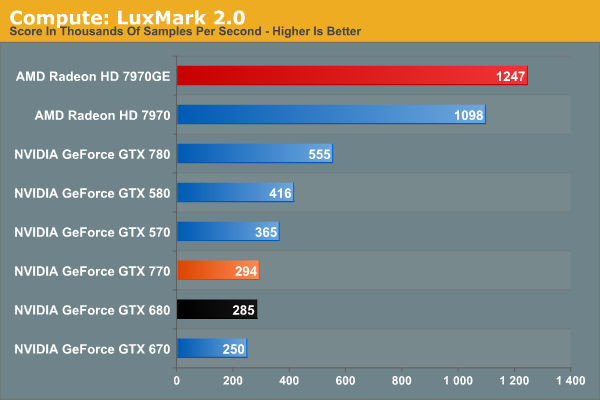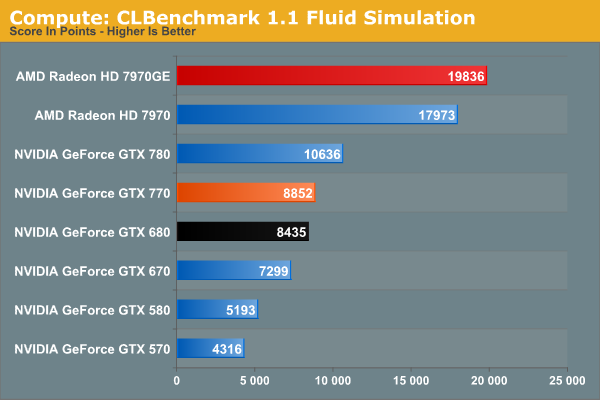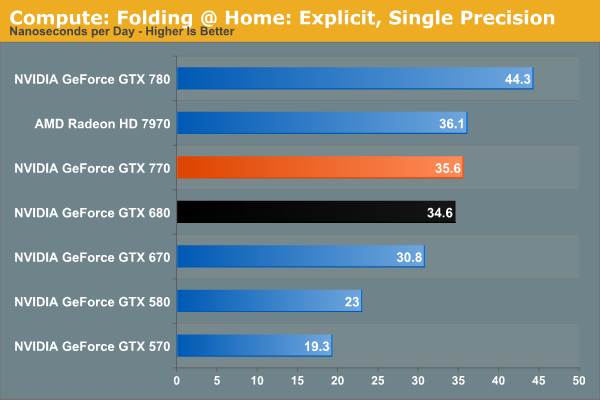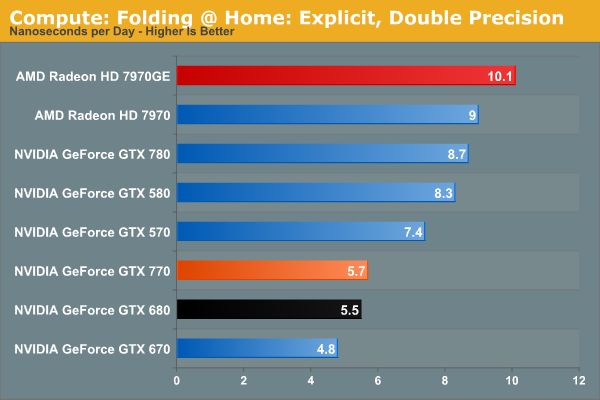NVIDIA GeForce GTX 770 Review: The $400 Fight
by Ryan Smith on May 30, 2013 9:00 AM ESTCompute
Jumping into compute, we aren’t expecting too much here. Outside of DirectCompute GK104 is generally a poor compute GPU, and other than the clockspeed boost GTX 770 doesn’t have much going for it.
As always we'll start with our DirectCompute game example, Civilization V, which uses DirectCompute to decompress textures on the fly. Civ V includes a sub-benchmark that exclusively tests the speed of their texture decompression algorithm by repeatedly decompressing the textures required for one of the game’s leader scenes. While DirectCompute is used in many games, this is one of the only games with a benchmark that can isolate the use of DirectCompute and its resulting performance.

Civilization V at least shows that NVIDIA’s DirectCompute performance is up to snuff in this case. Though as is the case with GTX 780, we’re reaching the limits of what this benchmark can do, due to just how fast modern cards have become.
Our next benchmark is LuxMark2.0, the official benchmark of SmallLuxGPU 2.0. SmallLuxGPU is an OpenCL accelerated ray tracer that is part of the larger LuxRender suite. Ray tracing has become a stronghold for GPUs in recent years as ray tracing maps well to GPU pipelines, allowing artists to render scenes much more quickly than with CPUs alone.

Moving on to a more general compute task, we get a reminder of how poor GK104 is here. GTX 770 can beat the slower GK104 products, and that’s it. Even GTX 570 is faster, never mind the massive lead that 7970GE holds.
Our 3rd benchmark set comes from CLBenchmark 1.1. CLBenchmark contains a number of subtests; we’re focusing on the most practical of them, the computer vision test and the fluid simulation test. The former being a useful proxy for computer imaging tasks where systems are required to parse images and identify features (e.g. humans), while fluid simulations are common in professional graphics work and games alike.


CLBenchmark paints GTX 770 in a better light than LuxMark, but not by a great deal. The gains over the GTX 680 are miniscule since these benchmarks aren’t memory bandwidth limited, and the gap between it and the 7970GE is nothing short of enormous.
Moving on, our 4th compute benchmark is FAHBench, the official Folding @ Home benchmark. Folding @ Home is the popular Stanford-backed research and distributed computing initiative that has work distributed to millions of volunteer computers over the internet, each of which is responsible for a tiny slice of a protein folding simulation. FAHBench can test both single precision and double precision floating point performance, with single precision being the most useful metric for most consumer cards due to their low double precision performance. Each precision has two modes, explicit and implicit, the difference being whether water atoms are included in the simulation, which adds quite a bit of work and overhead. This is another OpenCL test, as Folding @ Home has moved exclusively to OpenCL this year with FAHCore 17.


Recent core improvements in Folding @ Home continue to pay off for NVIDIA. In single precision the GTX 770 is just fast enough to hang with the 7970 vanilla, though the 7970GE is still over 10% faster. Double precision on the other hand is entirely in AMD’s favor thanks to GK104’s very poor FP64 performance.
Wrapping things up, our final compute benchmark is an in-house project developed by our very own Dr. Ian Cutress. SystemCompute is our first C++ AMP benchmark, utilizing Microsoft’s simple C++ extensions to allow the easy use of GPU computing in C++ programs. SystemCompute in turn is a collection of benchmarks for several different fundamental compute algorithms, as described in this previous article, with the final score represented in points. DirectCompute is the compute backend for C++ AMP on Windows, so this forms our other DirectCompute test.

Unlike our other compute benchmarks, System Compute is at least a little bit memory bandwidth sensitive, so GTX 770 pulls ahead of GTX 680 by 11%. Otherwise like every other compute benchmark, AMD’s cards fare far better here.










117 Comments
View All Comments
Catalina588 - Thursday, May 30, 2013 - link
Folding@Home Big-Time Discrepancy in reviewsCan anyone explain the material differences between this review's Compute Results for Folding@Home and the same FAHbench run at Tom's Hardware?
http://www.tomshardware.com/reviews/geforce-gtx-77...
Since FAHbench is self-contained -- load and go -- it's hard to figure how the results could be so different.
Ryan Smith - Thursday, May 30, 2013 - link
We're using a newer version of the benchmark, 1.2. FAHBench 1.2 has some very big performance optimizations that aren't in 1.1x.kyuu - Thursday, May 30, 2013 - link
Not bad, but I think I'd still just find a 7970 with a good cooler on sale and overclock the crap out of it if I was looking to buy a high-end GPU.Lt_dan - Thursday, May 30, 2013 - link
People should be looking at other websites. This review is showing scores that don't even make sense. The 7970, on bf3, has the same score as tomshardware's review of the 680, which was done over the year ago.azixtgo - Thursday, May 30, 2013 - link
nobody cares. If this were ~$300 I'd seriously consider it. But getting a 7950 for ~$300 along with 4 quality games just makes me not care about a $400 card thats already out of my budget anyway. Nvidia always keeps their best just too high. At 400 its competing in value against a card with more to offer. They don't have the concept of winning by pricing right, but I guess they've never had to go there like AMD did.Razorbak86 - Thursday, May 30, 2013 - link
Just because YOU don't care, doesn't mean that NOBODY cares. Please don't attempt to speak for the rest of us.agentwax - Thursday, May 30, 2013 - link
Hmm recently built a system with gigabyte 670 and was looking to go sli in the near future. Upon reading this review I'm second guessing. Should I get a second 670 in a few months and go sli Or a 770 and go sli some time around christmas? Very happy with temps and noise on gigabyte wind force 670thunderising - Friday, May 31, 2013 - link
Now it's time for a HD 7970 GHZ GHZ MEGA GHZ edition with faster clocks and a new driver release for improved performance. HeheheAt least that would be better than a HD8950 = HD 7970 with faster clock speeds.
evolucion8 - Friday, May 31, 2013 - link
That is not correct. The HD 7970 has a bigger bus, but being 28nm instead of 40nm like the HD 6970 means that the HD 7970 was able to achieve great performance gains by being 354mm2 compared to the HD 6970 which is around 389mm2colonelclaw - Friday, May 31, 2013 - link
Is anyone else as disappointed as I am about pricing all the way across the board with this new generation? As an owner of a GTX580 I was thinking it's about time for an upgrade, but all these high end cards look 100 $/£/€ overpriced to me. I wasn't happy about paying £450 for my 580 but there's no way in hell I'm prepared to pay £550 for the 780, and the 770 isn't a big enough upgrade to interest me.I'm more than a little suspicious that AMD and NVidia are agreeing on price points in order to make larger profits. Having just 2 companies in a market sector makes it pretty easy for them to do this.